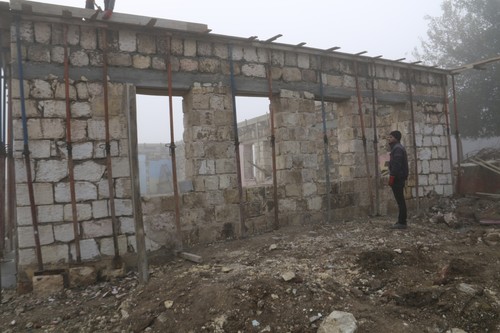© Turkuvaz Haberleşme ve Yayıncılık 2024
In Harran district of Turkey's Şanlıurfa province, a place where some of the first astronomy observations were made in the world, construction is underway to build an observatory which befits the fame of the district. In this observatory, opportunities for both observations and academic work will be offered.
The observatory is being built on a nearly 100-square-meters, close to historical ruins in the district, with the financial support of The Southeastern Anatolia Project (GAP) Regional Development Administration (BKİ) in cooperation with Harran District Governorship.
This is the district where Al-Battani, often Latinized as Albategnius, Albategni or Albatenius, one of the most well-known astronomers in history, conducted his celestial research.

The construction is to be completed soon.
In the garden of the observatory, whose dome will resemble a space shuttle, a huge spherical world model will be made. It is planned that both observational and academic works will be conducted in Harran, which is flooded by local and foreign tourists, like in the past.
The observatory is to become operational early next year. GAP BKİ President Sadrettin Karahocagil said that the depths of space have been explored by people throughout history.
There is an incredible universe in the sky, Karahocagil said and noted that they aim to bring the beauties of the sky and people on earth together. He added that the number of astronomy and space lovers increases rapidly.
The president reported that a beautiful investment was planned in Harran to facilitate the discovery of the sky. Stating the investment was made in cooperation with the municipality, governorship and provincial directorate of culture and tourism, Karahocagil said: "Harran University, or Harran Madrasah, which was accepted as the first university in the past, made serious discoveries in the field of astronomy. Harran is one of the places which are named after stars.
"In this context, we want to build an observatory. We want to emphasize this feature of Harran's past. Many observations were made here throughout history but they have not continued to the present. We want the sky to be examined here. While the sky is examined, we also want to see that scientific works are conducted. We also want our faculty members, interested in astronomy from our universities, especially from Harran University and across the region, benefit from this observatory. We are building an observatory with a capacity to address both aims. When our children and youth go there, they will have an opportunity to do research on astronomy."
Astronomic remains
Harran University Archaeology Department and Head of the Harran Archaeological Site Excavation, professor Mehmet Önal said that Harran is one of the oldest settlements in the world.
Stars can be seen comfortably at night as the air is dry in the region and Önal emphasized that the first astronomical works in the world were carried out in Harran due to the brightness of the sky here.
The professor said: "Harran was the center of science and astronomy in ancient times. Therefore, we are happy to see the observatory here. We will be in the same situation as we were in the old days of science with it. In Harran, the observation of astronomy and stars dates back 6,000 years. You can see the stars are glittering at night because the air is dry in Mesopotamia. Which is why in the past people explored the sky in the Mesopotamian region much earlier than in other geographical regions. The first gods, goddesses, beliefs and temples were created by the examination of this sky. There are many remains belonging to the moon god Sin, the sun god Shamash and the star god Ishtar here. Some of these remains are currently in the Şanlıurfa Archaeology Museum. In the ongoing excavations in the region, we also reveal some findings from astronomy from time to time."
Harran's scientific wealth
Mehmet Önal also drew attention to the fact that many scientists and astronomers grew up in Harran throughout history.
Implying Al-Battani is among these important figures, Önal emphasized that the observatory in the historical district carries particular importance. The professor highlighted that local and foreign tourists can better understand the scientific aspect of Harran thanks to the observatory.
"In the Middle Ages, we know that many scholars and astronomers grew up in Harran schools during the Islamic period. Al-Sabi Thabit ibn Qurra al-Harrani and Al-Battani were the most important ones among them. A crater on the moon was named after Al-Battani. He is known as the first astronomer inventor of the Islamic period. He particularly examined the movement of the moon and the sun closely. He was the inventor who discovered the astrolabe, which measures long distances. He is one of the 20 important astronomers in the world and this person is from Harran. It is important to have this observatory here to examine the stars and planets with powerful telescopes. We are pleased to see that Al-Battani's inventions are used in their place of origin. It is a great source of joy for us to bring Harran's forgotten scientific wealth and supremacy back to the present with this observatory," said the professor.
